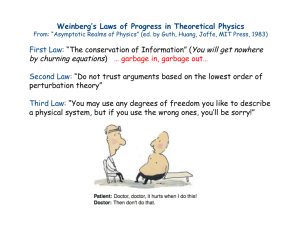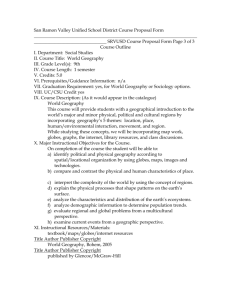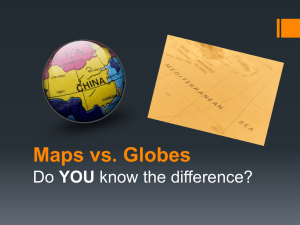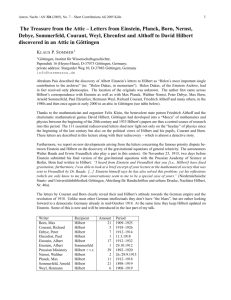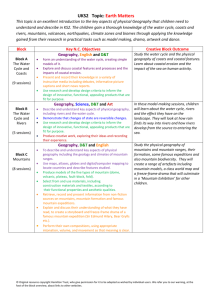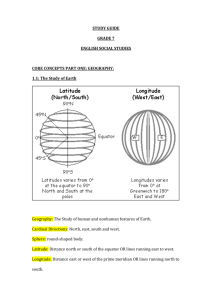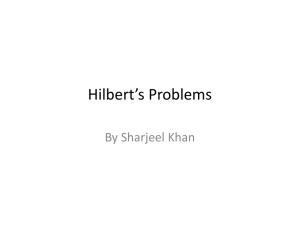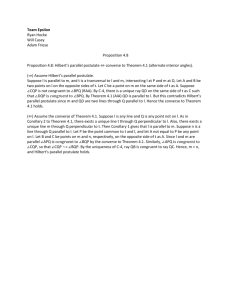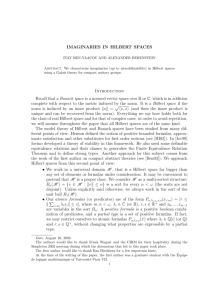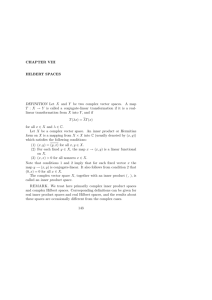Environmental Unit
advertisement
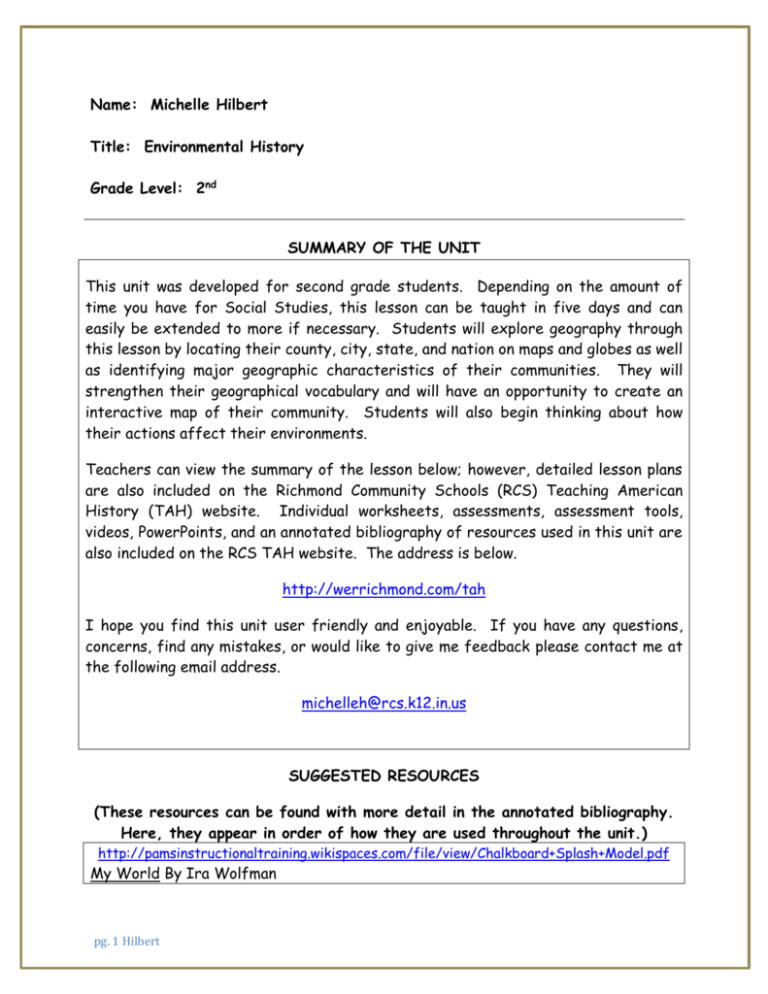
Name: Michelle Hilbert Title: Environmental History Grade Level: 2nd SUMMARY OF THE UNIT This unit was developed for second grade students. Depending on the amount of time you have for Social Studies, this lesson can be taught in five days and can easily be extended to more if necessary. Students will explore geography through this lesson by locating their county, city, state, and nation on maps and globes as well as identifying major geographic characteristics of their communities. They will strengthen their geographical vocabulary and will have an opportunity to create an interactive map of their community. Students will also begin thinking about how their actions affect their environments. Teachers can view the summary of the lesson below; however, detailed lesson plans are also included on the Richmond Community Schools (RCS) Teaching American History (TAH) website. Individual worksheets, assessments, assessment tools, videos, PowerPoints, and an annotated bibliography of resources used in this unit are also included on the RCS TAH website. The address is below. http://werrichmond.com/tah I hope you find this unit user friendly and enjoyable. If you have any questions, concerns, find any mistakes, or would like to give me feedback please contact me at the following email address. michelleh@rcs.k12.in.us SUGGESTED RESOURCES (These resources can be found with more detail in the annotated bibliography. Here, they appear in order of how they are used throughout the unit.) http://pamsinstructionaltraining.wikispaces.com/file/view/Chalkboard+Splash+Model.pdf My World By Ira Wolfman pg. 1 Hilbert The Earth and I By Frank Asch The Big Indiana Reproducible Activity Book By Carole Marsh http://www.superteacherworksheets.com/maps.html http://www.readingquest.org/strat/321.html http://www.ascd.org/publications/books/111037/chapters/TPT_Hold-Ups.aspx http://www.facinghistory.org/resources/strategies/graffiti-boards http://nrhs.nred.org/www/nred_nrhs/site/hosting/Literacy%20Website/Literacy %20Strategy%20Templates/Quick_Write__description.pdf Marvelous Map Activities for Young Learners by Minnie Ashcraft http://youtu.be/gRYSSNq5GSc http://www.superteacherworksheets.com/maps/mapskills-castle_WMZNQ.pdf http://www.teachervision.fen.com/tv/printables/orange/ss-3.pdf http://www.readingquest.org/strat/tps.html MATERIALS NEEDED Globes and Maps Yellow –orange-brown colored sand (kitty litter as a substitute) Plastic dishpans for mini sandboxes OR sandtable OR inflatable wading pool Drop cloth or gardening plastic Items to represent utilities, homes, schools, other buildings and objects in a community, examples may be yarn, straws, pipe cleaners, markers, different colored dots, paper clips, erasers, rocks, etc. Post – It Notes Geography Check List (attached to lesson plan and found on website) 3-2-1 Form (website) Geography Scramble Sheet (attached to lesson plan and found on website) Smartboard Smartboard Exchange Hold Ups / Response Cards Large paper for Graffiti Wall or another object such as whiteboard, chalkboard Ipad and applications Teacher Picks and Stack the States Construction Paper Scissors Glue pg. 2 Hilbert VOCABULARY Geography State West Neighborhood Country Mountain Locations Landmarks Continent Symbol Hill Island Map Legend Lake Globe Boundary Line River Compass Rose North Ocean Compass South Map Key East pg. 3 Hilbert STAGE 1 – Identify desired results Competencies/Standards Reading Standards for Informational Text K–5 5 Know and use various text features (e.g., captions, bold print, subheadings, glossaries, indexes, electronic menus, icons) to locate key facts or information in a text efficiently. Reading Standards: Foundational Skills (K–5) Writing Standards K–5 2 Write informative/explanatory texts in which they introduce a topic, use facts and definitions to develop points, and provide a concluding statement or section. 5. With guidance and support from adults and peers, focus on a topic and strengthen writing as needed by revising and editing. 6. With guidance and support from adults, use a variety of digital tools to produce and publish writing, including in collaboration with peers. 8. Recall information from experiences or gather information from provided sources to answer a question. Speaking and Listening Standards K–5 1. Participate in collaborative conversations with diverse partners about grade 2 topics and texts with peers and adults in small and larger groups. a. Follow agreed-upon rules for discussions (e.g., gaining the floor in respectful ways, listening to others with care, speaking one at a time about the topics and texts under discussion). b. Build on others’ talk in conversations by linking their comments to the remarks of others. c. Ask for clarification and further explanation as needed about the topics and texts under discussion. 2. Recount or describe key ideas or details from a text read aloud or information presented orally or through other media. pg. 4 Hilbert 3. Ask and answer questions about what a speaker says in order to clarify comprehension, gather additional information, or deepen understanding of a topic or issue. 4. Tell a story or recount an experience with appropriate facts and relevant, descriptive details, speaking audibly in coherent sentences. 5. Create audio recordings of stories or poems; add drawings or other visual displays to stories or recounts of experiences when appropriate to clarify ideas, thoughts, and feelings. 6. Produce complete sentences when appropriate to task and situation in order to provide requested detail or clarification. Language Standards K–5 1. Demonstrate command of the conventions of standard English grammar and usage when writing or speaking. a. Use collective nouns (e.g., group). b. Form and use frequently occurring irregular plural nouns (e.g., feet, children, teeth, mice, fish). c. Use reflexive pronouns (e.g., myself, ourselves). d. Form and use the past tense of frequently occurring irregular verbs (e.g., sat, hid, told). e. Use adjectives and adverbs, and choose between them depending on what is to be modified. f. Produce, expand, and rearrange complete simple and compound sentences (e.g., The boy watched the movie; The little boy watched the movie; The action movie was watched by the little boy). 2. Demonstrate command of the conventions of standard English capitalization, punctuation, and spelling when writing. a. Capitalize holidays, product names, and geographic names. b. Use commas in greetings and closings of letters. c. Use an apostrophe to form contractions and frequently occurring possessives. d. Generalize learned spelling patterns when writing words (e.g., cage → badge; boy → boil). e. Consult reference materials, including beginning dictionaries, as needed to check and correct spellings. 3. Use knowledge of language and its conventions when writing, speaking, reading, or listening. 5. Demonstrate understanding of word relationships and nuances in word meanings. pg. 5 Hilbert 6. Use words and phrases acquired through conversations, reading and being read to, and responding to texts, including using adjectives and adverbs to describe (e.g., When other kids are happy that makes me happy). Enduring Understandings (“Students will understand THAT…”) Overarching Enduring Understandings Students will understand that a person can be in more than one place at one time. Students will develop knowledge of the earth to locate people, places, and environments. Topical Enduring Understandings Students will understand how to use globes, maps, and atlases. Students will understand how to read a map by interacting with technology. Students will understand map features with focus on directions, map keys, colors, and other details. Students will understand the cardinal directions. Essential Questions (“How…” “Why…” “To what extent…”) Overarching Essential Questions Where are you? How can a person be in more than one place at one time? How do you give directions to someone who is lost? Topical Essential Questions How do we use globes, maps, and atlases? Why do we use globes, maps, and atlases? How would our world be different if we did not have globes, maps, and atlases? pg. 6 Hilbert Enabling Knowledge and Skills (“What skills and conceptual knowledge must students possess in order to demonstrate understanding – especially on performance tasks?”) Students will know Students will be able Students will know how to read a map. Students will be able to use cardinal directions on a map. pg. 7 Hilbert STAGE 2 – Determine acceptable evidence Overview of assessment evidence Briefly describe the types of assessment activities you will use throughout this unit to ensure students are gaining the enabling conceptual knowledge and skills they need so that ultimately they can demonstrate understanding through the major performance task. TYPE OF EVIDENCE Primary performance task Written prompts/ journals Small projects/skill demonstrations/ supporting performances Student selfassessments pg. 8 Hilbert DESCRIPTION OF THE ASSESSMENT ACTIVITY WHICH FACET OF UNDERSTANDING IS EMPHASIZED? 1. Use of globes, maps, and atlases 2. Sand Table Mapping Application, interpretation, perspective 1. How to Read a Map PowerPoint Quiz Quick Write 2. 3-2-1 3. Newsletter to Families Explanation, interpretation, perspective, selfknowledge 1. A Quilt of Many Counties 2. United State of America Map 3. How to Read a Map Smartboard Exchange Program 4. Use of globes, maps, and atlases 5. Marvelous Map Activities for Young Learners Application, explanation 1. Chalkboard Splash 2. 3-2-1 3. How to Read a Map PowerPoint Quiz 4. Maps- An Intro for Kids Interpretation, selfknowledge, explanation Observing /conferencing Quizzes/ tests Other pg. 9 Hilbert 1. Graffiti Wall 2. Stories and discussions 1. How to Read a Map PowerPoint Quiz 2. How to Read a Map Quick Write 3. Royal Castle Floor Plan Activity 4. Sand Table Mapping 5. Newsletter Interpretation, explanation, perspective, empathy, self-knowledge Self-knowledge Perspective Interpretation GRASPS details for the primary performance task Use the GRASP format to provide more detailed information about the primary performance task through which you will assess students’ growing understanding. GRASPS Use of GRASPS in this Unit Goal Provide a Students will learn map concepts and cardinal directions. statement of the The goal is for students to understand that they can be in more than one place at one time. task. Establish the goal, problem, challenge, or obstacle in the task. Students will work as eager learners to learn new Role Define the role of geographical concepts and participate in activities that the students in the demonstrate their new knowledge. task. State the job of the students for the task. The teacher, parents, classmates, and other students are Audience Identify the the audience. target audience within the context of the scenario. Example audiences might include a client or a committee. Students will create a Sand Table Map and a Newsletter to Situation Set the context of demonstrate their knowledge. the scenario. Explain the situation. Product pg. 10 Hilbert Students will create a Sand Table Map and a Newsletter to Clarify what the demonstrate their knowledge. students will create and why they will create it. Standards and Rubrics will be used to access students. The teacher resource book 50 Social Studies Strategies for K-8 Criteria Provide students Classrooms Third Edition by Kathyrn M. Obenchain and with a clear picture Ronald V. Morris will be used in developing a rubric. of success. Identify specific standards for success. Issue rubrics to the students. pg. 11 Hilbert STAGE 3 – Design learning activities Use the WHERETO model to identify the type – but not the sequence – of instructional activities required to promote the desired results. Following the WHERETO model is an optional calendar for actually scheduling the sequence of learning activities. Note that assessment activities (the second “E” and to some extent the “R” in WHERETO) are embedded throughout the unit. WHERETO “W” Ideas W How will you ensure that all students know where they are headed in the unit, why they are headed there, and how they will be evaluated? H How will you hook students at the beginning of the unit? “H” Ideas “E1” Ideas E What events will help students experience and explore the big ideas and questions in the unit? How will you equip them with needed skills and knowledge? R How will you cause students to reflect and rethink? How will you guide them in rehearsing, revising, and refining their work? “R” Ideas Class and partner discussions, think pair shares, and special strategies to get students to reflect. E How will you help students to exhibit and self-evaluate their growing skills, knowledge, and understanding throughout the unit? “E2” Ideas Class and partner discussions, think pair shares, and special strategies to get students to reflect. pg. 12 Hilbert Direct communication, chalkboard splashes, graffiti walls, 3-2-1 Forms, and rubrics will be used throughout the unit. Chalkboard Splash and discussion will take place during the first day. Use of technology, hands on activities, and discussion strategies will help them. “T” Ideas T How will you tailor instruction to meet student need in readiness, learning style, and interest while remaining true to the desired result? O How will you organize learning experiences to maximize engagement and understanding and minimize misconceptions? “O” Ideas I will allow plenty of time for questioning and discussion. Through the use of different strategies and teacher observation adjustments to the lesson will be made as needed. Sequence of unit learning and assessment activities Calendar Monday Unit Introduction Tuesday Wednesday Thursday Friday Graffiti Wall Maps: An Intro for Kids Video Table Sand Map Table Sand Map Social Studies Strategy Page 175 Social Studies Strategy Chalkboard Splash How to Read a Map By Becky Arnett The Armadillo from Interactive Amarillo By Lynne My World By Ira Smartboard Lesson Cherry Wolfman The Earth and I By Frank Asch My Geography Words Book pg. 13 Hilbert Hold Up Response Cards Quiz Scrambled Geography Words How to Read a Map - Quick Write Geography Word Cards My Geography Words Book Royal Castle Floor Plan Page 175

